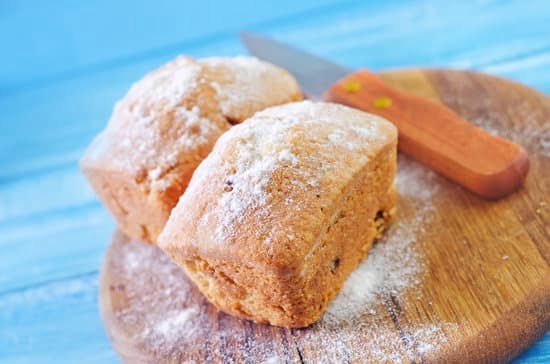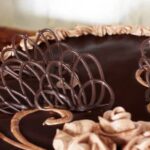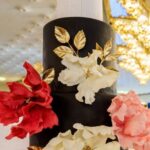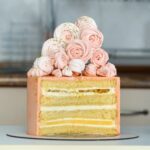Are you a baking enthusiast or a professional pastry chef looking to up your cake decorating game? Look no further than the turning table for cake decorating. This innovative tool has revolutionized the art of cake decoration, making it easier and more efficient than ever before.
A turning table, also known as a revolving cake stand or decorating turntable, is an essential tool for anyone who loves to decorate cakes. Its rotating feature allows decorators to easily spin and access all sides of the cake, resulting in precise and evenly decorated masterpieces.
In this article, we will explore the benefits of using a turning table for cake decorating, the different types available in the market, how to choose the right one for your needs, and a step-by-step guide on how to use it effectively. Additionally, we will share some expert tips and tricks as well as common mistakes to avoid when using a turning table.
We will also take a look at the future of turning tables for cake decorating, including any upcoming innovations and trends in this essential tool for cake decorators.
Benefits of Using a Turning Table for Cake Decorating
Turning tables for cake decorating are a game changer for bakers and cake decorators. They offer numerous benefits that can enhance the quality and efficiency of cake decorating. Here are some key benefits of using a turning table for cake decorating:
- 360-degree rotation: Turning tables allow for smooth and seamless rotation, enabling decorators to easily access all angles of the cake without having to constantly adjust its position. This makes it much easier to apply icing, fondant, or other decorations evenly around the entire cake.
- Precision and control: With a turning table, decorators have better control over their decorating tools, resulting in more precise and detailed designs. This is especially beneficial when working on intricate patterns or delicate designs that require steady hands and careful maneuvering.
- Comfort and convenience: Using a turning table reduces the need to constantly move around the cake, as decorators can simply rotate the table to reach different areas. This not only saves time and effort but also minimizes the risk of accidentally smudging or damaging the decorations.
In addition to these benefits, turning tables also promote a more ergonomic work environment by allowing decorators to maintain a comfortable posture while working. Ultimately, incorporating a turning table into your cake decorating routine can greatly improve the overall quality and professionalism of your finished products.
Types of Turning Tables for Cake Decorating
Turning tables for cake decorating come in various shapes and sizes, each designed to meet the specific needs of cake decorators. One of the most common types is the manual turning table, which requires the user to rotate the table by hand. This type is typically more affordable and suitable for beginners or hobbyists.
Another type is the electric turning table, which rotates automatically with the push of a button. This type is ideal for professional cake decorators or those who handle a high volume of cake orders.
In addition to manual and electric turning tables, there are also specialized rotating stands designed for specific purposes such as airbrushing or fondant work. These rotating stands often come with additional features such as adjustable speed settings or interchangeable platforms for added versatility.
When choosing a turning table for cake decorating, it’s important to consider factors such as size, weight capacity, and durability. Smaller tables are suitable for individual-sized cakes or cupcakes, while larger tables can accommodate tiered cakes or bigger projects. Tables with a higher weight capacity are essential for supporting heavy cakes without wobbling.
Ultimately, the type of turning table that’s best for you will depend on your skill level, budget, and specific needs as a cake decorator.
| Types of Turning Tables | Description |
|---|---|
| Manual Turning Table | Requires manual rotation by hand; more affordable and suitable for beginners or hobbyists |
| Electric Turning Table | Rotates automatically with the push of a button; ideal for professional cake decorators or high-volume orders |
| Specialized Rotating Stands | Designed for specific purposes such as airbrushing or fondant work; may have adjustable speed settings and interchangeable platforms |
How to Choose the Right Turning Table for Cake Decorating
When it comes to choosing the right turning table for cake decorating, there are a few key factors to consider. First and foremost, you’ll want to think about the size of the turning table. Larger turning tables can accommodate bigger cakes and provide more room for decorating, while smaller ones may be sufficient for more petite cakes.
Additionally, consider whether you want a manual or electric turning table. Manual turning tables require you to physically spin the platform, while electric ones do the work for you at the push of a button.
Another important factor to keep in mind is stability. You’ll want a turning table that is sturdy and won’t wobble or shake while you’re working on delicate cake decorations. Look for turning tables with non-slip bases or added features like suction cups for extra stability. Additionally, consider the material of the turning table – some decorators prefer plastic for its light weight and affordability, while others prefer heavy-duty materials like metal for added durability.
Lastly, think about your budget and how much you’re willing to invest in a turning table for cake decorating. There are options available at various price points, so whether you’re a hobbyist or a professional baker, there’s likely a turning table that fits within your budget. Keep in mind that investing in a quality turning table can make a significant difference in your cake decorating experience and end results.
| Factors | Description |
|---|---|
| Size | Consider the size of the turning table based on your cake size and space requirements. |
| Stability | Look for stable options with non-slip bases or added features like suction cups. |
| Material | Consider the material of the turning table – plastic for affordability or metal for durability. |
| Budget | Think about how much you’re willing to invest in a quality turning table based on your needs and preferences. |
Step-by-Step Guide on Using a Turning Table for Cake Decorating
Using a turning table for cake decorating can make the process much easier and efficient. Here is a step-by-step guide on how to use a turning table for cake decorating:
1. Prepare your cake: Before using the turning table, ensure that your cake is baked, cooled, and ready to be decorated. Place the cake on a flat surface and add a layer of frosting or buttercream to the top and sides of the cake.
2. Place the turning table: Place the turning table on a stable surface such as a countertop or table. Make sure it is secure and does not wobble when you rotate it.
3. Position the cake: Carefully lift the prepared cake and place it in the center of the turning table. Gently press down to ensure that it is secure and centered on the table.
4. Begin decorating: Start by adding more frosting or decorative elements to your cake while slowly rotating the turning table. Use a spatula or piping bag to create designs, patterns, or smooth out any imperfections in your frosting.
5. Rotate as needed: As you decorate, continue rotating the turning table to access different areas of the cake easily. This will allow you to achieve even coverage and consistent decoration around the entire cake.
6. Finishing touches: Once you are satisfied with your decorating, carefully stop rotating the turning table and put on any final touches or details as needed.
Remember that practice makes perfect when using a turning table for cake decorating, so don’t be discouraged if it takes time to get used to using this tool effectively.
Tips and Tricks for Using a Turning Table for Cake Decorating
Choosing the Right Tools and Materials
When using a turning table for cake decorating, it is important to have the right tools and materials on hand. A good quality offset spatula, piping bags and tips, fondant smoothers, and a variety of edible decorations are essential. Make sure to also have a non-slip mat or pad to place the turning table on to prevent it from sliding around while you work.
Working With Buttercream and Fondant
For buttercream frosting, chilling the cake before decorating can make working with the turning table much easier. This helps to create smoother lines and cleaner designs. When working with fondant, be sure to roll it out evenly and gently lift it onto the cake using rolling pins or your hands. The turning table makes it easy to smooth out any air bubbles or wrinkles in the fondant while giving your cake a professional finish.
Experimenting With Different Techniques
One of the benefits of using a turning table for cake decorating is that it allows you to try out different techniques easily. Practice creating textured designs, smooth finishes, and intricate piping work with ease as you turn the table. You can also experiment with painting on cakes by spinning the turning table as you work.
By mastering these tips and tricks for using a turning table for cake decorating, you can elevate your skills and create stunning cakes that are sure to impress any crowd. Whether you are a beginner or experienced decorator, incorporating a turning table into your toolkit can take your creations to the next level.
Common Mistakes to Avoid When Using a Turning Table for Cake Decorating
When using a turning table for cake decorating, there are several common mistakes that beginners often make. By being aware of these mistakes, you can improve your cake decorating skills and create stunning designs with ease.
Improper Speed Control
One common mistake when using a turning table for cake decorating is not controlling the speed of the turntable properly. It’s important to find the right balance between turning too quickly and too slowly. Turning too fast can make it difficult to control your piping or icing, while turning too slow can cause uneven decorations. Experiment with different speeds to find what works best for you.
Overloading the Cake
Another mistake to avoid is overloading the cake with heavy decorations or layers of icing while it is on the turning table. This can cause the cake to become off-center or even topple over. It’s important to keep in mind the weight distribution of your decorations and to work in small, manageable sections to maintain stability.
Not Securing the Cake Properly
Failing to secure the cake properly on the turning table is also a common mistake that can lead to disaster. Make sure your cake is placed securely on the turntable and consider using a non-slip mat or parchment paper underneath for added stability.
Avoiding these common mistakes when using a turning table for cake decorating will help you achieve professional-looking results and enhance your overall experience in creating beautiful and delicious cakes.
The Future of Turning Tables for Cake Decorating
In conclusion, the future of turning tables for cake decorating looks bright, with a range of innovations and trends on the horizon. As technology continues to advance, we can expect to see more sophisticated turning tables that offer enhanced precision and control for decorators. This will enable cake decorators to create even more intricate and stunning designs with ease.
One exciting trend that is emerging in the world of turning tables for cake decorating is the integration of smart features. This includes Bluetooth connectivity, touch screen interfaces, and compatibility with design software. These advancements will streamline the decorating process and open up new creative possibilities for decorators.
Furthermore, we can anticipate an expansion in the variety of turning tables available on the market. As demand for these tools continues to grow, manufacturers are likely to develop new models tailored to different sizes and types of cakes. This will provide decorators with even more options to find the perfect turning table for their specific needs.
Overall, it’s clear that turning tables for cake decorating are set to undergo significant developments in the coming years. With an array of innovative features and options becoming available, decorators can look forward to a future where creating beautiful cakes is not only easier but also more enjoyable than ever before.
Frequently Asked Questions
What Can I Use Instead of a Turning Table?
Instead of a turning table, you can use a cake stand or even a regular rotating kitchen turntable. These can both help with decorating and frosting cakes without needing to invest in a specialized cake turntable.
Do You Really Need a Cake Turntable?
Whether or not you really need a cake turntable depends on how often you bake and decorate cakes. If you frequently work with cakes and enjoy decorating them, a cake turntable can definitely make the process easier and more professional-looking.
Which Turntable Is Best for Cake?
The best turntable for cakes depends on your specific needs and preferences. Some popular options include the Ateco Revolving Cake Stand, Wilton Tilt-N-Turn Ultra Cake Turntable, and the Cake Boss Decorating Turntable. Consider factors like size, stability, and ease of rotation when choosing the best one for your needs.

Welcome to our cake decorating blog! My name is Destiny Flores, and I am the proud owner of a cake decorating business named Cake Karma. Our mission is to provide delicious, beautiful cakes for all occasions. We specialize in creating custom cakes that are tailored specifically to each customer’s individual needs and tastes.





